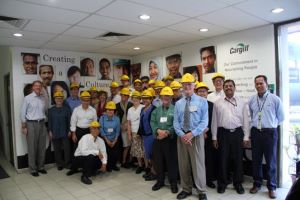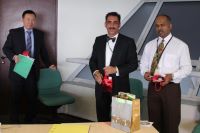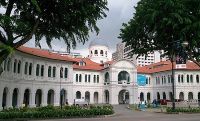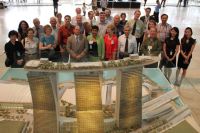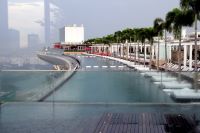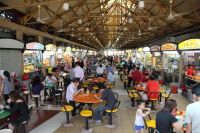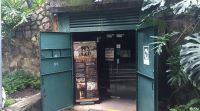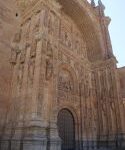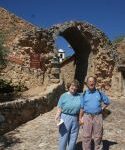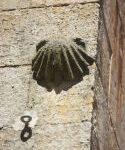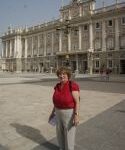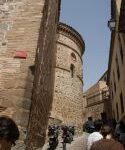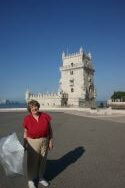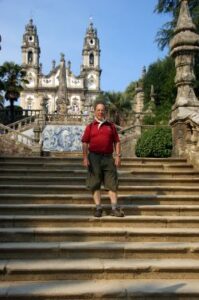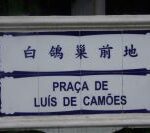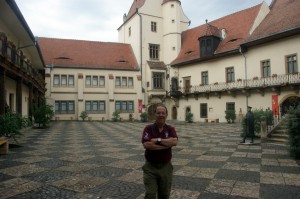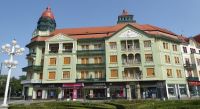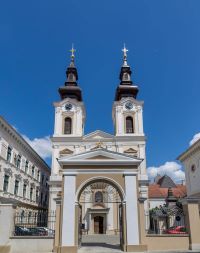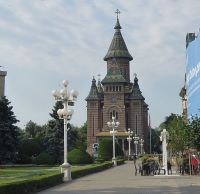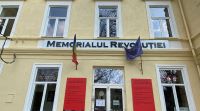May 30, 2010
Today did nothing to dampen my ardor. The day began with sunshine (which lasted at least till about 9:15 tonight) and a brisk walk around the hotel. I had little knowledge and few expectations about the city, other than that it had not been destroyed in World War II (though its population was decimated) and had many Italianate features. The city bills itself not as “The Paris of the East,” or “Little Paris,” but as the “Florence of the East.” Personally, I think it looks more Austrian, but that may be because it was under Austrian rule from the early 18th century, and many of the remaining older buildings date from that period, designed by Italian or Austrian architects, or the decor from Austrian designers; the central area in other words is impressive, especially when you consider that Lvov has never really been the capital of a country, merely, under Austria, the capital of the province of Galicia.
Even today, Kiev is the capital of Ukraine, while Lvov likes to say it is the “cultural” capital of the country. It certainly has a different feel than Kiev, partly because Catholicism held sway (it belonged to Poland before it was part of Austria, and was part of Poland from 1918 until 1939). When Carolyn and I did our cruise from Kiev to the Black Sea a few years ago, I asked the English speakers, mostly non-Americans (and a lot of English expats living in South Africa) if they thought we were in Europe; they roundly said, “NO.” I don’t think they’d have said that about Lvov.
I knew I was going to enjoy the guide, who arrived just before 9; she handed me a map and asked me what I wanted to see. Both were firsts on the trip. Usually, we’ve been told what we’re going to see, and only one previous guide handed out maps (and she handed out 8 for the 29 of us). I asked to see what was left of the ghetto, because before the second World War, the population was 25 percent Jewish; I know my maternal grandparents came from Poland, but Poland as such did not exist until 1919; I think they came from Russian Poland–so perhaps here, but there’s little left other than a deli and some buildings, and plans for reconstruction.
The guide spent four hours showing me the city, which has some architecturally superb churches. There’s an Armenian church, because 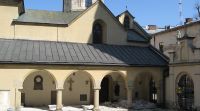 Armenian traders came here early (I think after the Mongol period; yes, my friends from the steppes of central Asia overran Lvov) and still remain part of the firmament. The German churches remain in a city they called Lemberg in Austrian days, though the community got dispersed after World War II, sent to Siberia or to Germany. So did many Polish churches, though many Poles were sent to Wroclaw,
Armenian traders came here early (I think after the Mongol period; yes, my friends from the steppes of central Asia overran Lvov) and still remain part of the firmament. The German churches remain in a city they called Lemberg in Austrian days, though the community got dispersed after World War II, sent to Siberia or to Germany. So did many Polish churches, though many Poles were sent to Wroclaw, 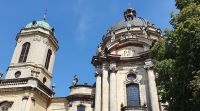 which under redivision of Europe, went to Poland as the border shifted to the West (and Lvov went from Poland to Russia), and the usual Dominican/Jesuit/Benedictine churches; the Orthodox churches came mostly 20th century, as the Polish majority were Catholic. Many former Roman Churches now house Greek-Catholic congregations, which do the Eastern rites, but follow the Pope. Don’t ask.
which under redivision of Europe, went to Poland as the border shifted to the West (and Lvov went from Poland to Russia), and the usual Dominican/Jesuit/Benedictine churches; the Orthodox churches came mostly 20th century, as the Polish majority were Catholic. Many former Roman Churches now house Greek-Catholic congregations, which do the Eastern rites, but follow the Pope. Don’t ask.
One of the churches might well be (on the inside especially) the prettiest one I’ve seen on this trip. Of course there were still some fortifications, but the city fathers tore most down as useless in the late 19th century, ignorant of the potential for tourism in the 21st, though a few remnants dot the center, and are incorporated into some of the museums.
She pointed out the museums for later consumption, so after she left me, I was able to visit six (and spend some time in some; there’s little English here, much less than anywhere else I’ve been on this trip, and while I can read the Cyrillic alphabet, my vocabulary is limited. Hence, I can cover a 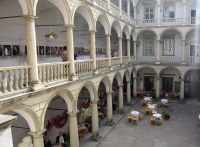 lot). Several of them were in former palaces, themselves well worth the entrance fee; one I had to see had been the local residence of Jon III Sobieski, who commanded the armies that in 1683 relieved the siege of Vienna and began the long rollback of the Ottoman Empire (Europeans seem to relive the Ottoman wars more than the Sobieski support), and another sported a large collection of icons, a few from before the Mongol period, collected by one of the Church
lot). Several of them were in former palaces, themselves well worth the entrance fee; one I had to see had been the local residence of Jon III Sobieski, who commanded the armies that in 1683 relieved the siege of Vienna and began the long rollback of the Ottoman Empire (Europeans seem to relive the Ottoman wars more than the Sobieski support), and another sported a large collection of icons, a few from before the Mongol period, collected by one of the Church 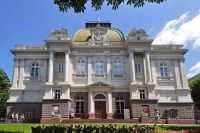 officials and housed in I believe a former Governor’s palace.
officials and housed in I believe a former Governor’s palace.
Maybe the one that fascinated me most was the one supposedly about the Ukrainian diaspora (as my Scouts know, there’s a Ukrainian community in Winnipeg, because we’ve had pierogies there several times). It gave the Ukrainian side of the accession of Poland (I saw the Polish side in Warsaw, and they’re quite different). When the Austrian empire blew up after World War I, Western Ukraine declared its independence. Poland declared war on the Soviets; the Red (Bolshevik) and White (anti-Bolshevik) armies fought the Ukrainians, with the result that Ukraine got split between Poland and Russia. The Russian Ukrainians fared worse; when Stalin took power, he pursued a relentless subjugation policy. From what I remember, between the civil war and a Soviet-imposed Sovietification, 10 million Ukrainians died. When the Germans came in, the Ukrainians initially welcomed them–until the Germans started to do the same extermination that the Russians had done. There was a partisan group that resisted both until the late 1940s. They’re popular heroes today, and I’ll detail going to a partisan-theme restaurant tonight if you’ll be patient.
There was a ballet today in the Opera House, and I decided I had to go. I think the last ballet I saw before this trip might well have been 8 years ago in Budapest. I hadn’t heard of the composer before–Ludwig (nee Leon Fyodorovich) Minkus–but a real orchestra, the elegant Opera House, and an otherwise unoccupied evening made the $7 ticket quite a bargain. Minkus wrote La Bayadere in 1877, so the music was romantic, the dancing and staging quite superb, and the storyline quite complex. Suffice to say, everyone died in the ballet. Wikipedia says one of the acts is a standard for displaying excellence.
My guide had pointed out a theme restaurant to me–one dedicated to the Ukrainian Partisan Army. I tried to find it last night, but there’s no sign outside (don’t want to be captured, do we?). When I got to the door, a uniformed guard pointed a machine gun at me (I hope it wasn’t loaded) and shouted something in Ukrainian at me; I think it was their slogan, 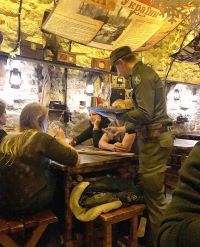 something like, “Glory to the Ukraine.” I was given the password, which I think was “Glory to our heroes.” I was admitted to a bunker like basement, with uniformed waiters who periodically did close order drill, and a wandering musical team that roused the crowd with patriotic songs that only one person there (me) did not know. Quite kitsch, with a great Ukrainian meal of dumplings with sour cream, better borscht than grandma, and a sausage/potatoes/tomatoes dish that had some name like sergeant’s delight.
something like, “Glory to the Ukraine.” I was given the password, which I think was “Glory to our heroes.” I was admitted to a bunker like basement, with uniformed waiters who periodically did close order drill, and a wandering musical team that roused the crowd with patriotic songs that only one person there (me) did not know. Quite kitsch, with a great Ukrainian meal of dumplings with sour cream, better borscht than grandma, and a sausage/potatoes/tomatoes dish that had some name like sergeant’s delight.
Withal, a day that capped a lot of the last month’s activities. Peter the Great came here and stayed in the only house that had a big enough doorway for him (he was tall, even for those times); he came to negotiate with the Polish landlords to get their help into putting an end to Sweden as an aggressive power (in the 21-year Great Northern War). The Austro-Hungarian Empire was here, and for a long time so was Poland. The Russian hegemony was fairly recent, and is still resented in some circles. Russia has been putting (Putin?) pressure on Ukraine. If you’ve followed the country in the past few months, a pro-Russian prime minister caused fist fights in Parliament by pushing through a bill extending the Russian lease to the naval base in the Black Sea port of Sevastopol. From what I read, people in western Ukraine would like to realize the dreams of 1918, when Western Ukraine was a country. They’d welcome NATO and the EU, I’ll bet.
Well, Professor Pana, you were right. I did fall in love with Romania, but you can see some newer country has come along and turned my head. Don’t feel bad, though; I bet Tuesday I’ll fall back in love with Bloomington. I love where I am, though I’ll miss where I’ve been. To quote one of my Scouts who was 12 at the time, Eastern Europe, “I’ll always remember you.”
I wish you all a pleasant journey. I’ve certainly had one in what other people have called “the forgotten half” of Europe.
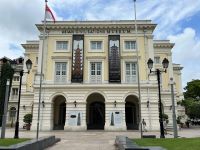 in the Lonely Planet that the museum housed an outstanding Muslim exhibit. Since we’re leaving later this a.m. for Malaysia, a Muslim country, I thought I’d better “be prepared.” What I was unprepared for were the excellent explanations, so good that I bought the collection catalogue, something I’m loathe to do, because they’re heavy!
in the Lonely Planet that the museum housed an outstanding Muslim exhibit. Since we’re leaving later this a.m. for Malaysia, a Muslim country, I thought I’d better “be prepared.” What I was unprepared for were the excellent explanations, so good that I bought the collection catalogue, something I’m loathe to do, because they’re heavy!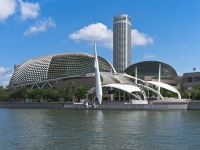 Esplanade, a new venue on the harbor that looks like a durian fruit (the one that smells like hell, but tastes like heaven–fortunately, the Esplanade smelled pretty good) that’s relatively new and reputedly had great characteristics. The program was two Tchaikovsky pieces I had never heard of (does anyone not in a music appreciation class know that he wrote 3 piano concerti? We heard the second). The second piece was the Manfred Symphony–toward the end the organ entered. Aside from Saint Saen’s famous organ symphony, I’d not known of any similar combination before.
Esplanade, a new venue on the harbor that looks like a durian fruit (the one that smells like hell, but tastes like heaven–fortunately, the Esplanade smelled pretty good) that’s relatively new and reputedly had great characteristics. The program was two Tchaikovsky pieces I had never heard of (does anyone not in a music appreciation class know that he wrote 3 piano concerti? We heard the second). The second piece was the Manfred Symphony–toward the end the organ entered. Aside from Saint Saen’s famous organ symphony, I’d not known of any similar combination before.